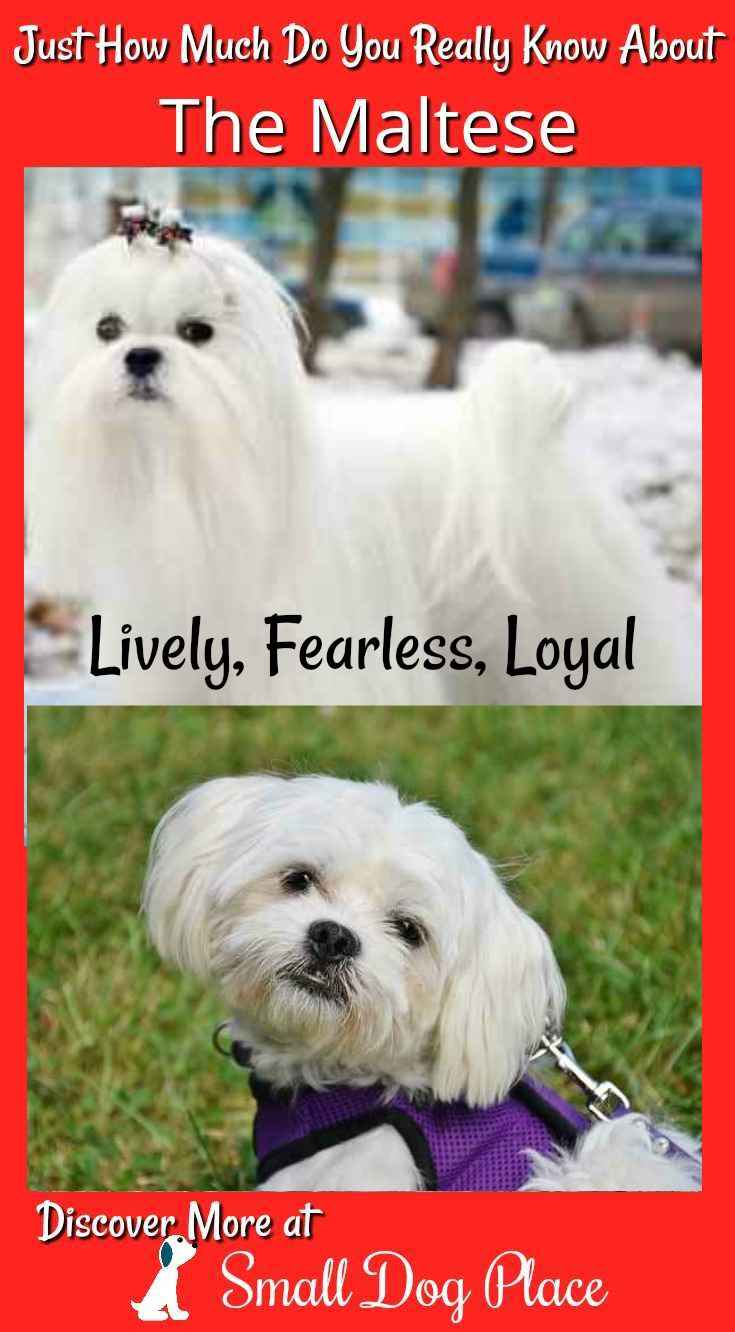- Small Dog Place Home
- A-Z Breeds A to M
- Maltese Dogs
Maltese Dogs:
Ye Ancient Dogge of Malta" Or, Your, Next Best Friend?
Maltese Dogs By Janice Jones |Updated 04-11-2023
Nicknamed "Ye Ancient Dogge of Malta," Maltese dogs are fearless, friendly, social-able dogs who are full of energy and always ready to interact with his favorite human.
As breeds go, the Maltese is an ancient one possibly dating back to the third century BC.
They may be descended from a Spitz breed or Tibetan terrier, but their true origin is unknown.
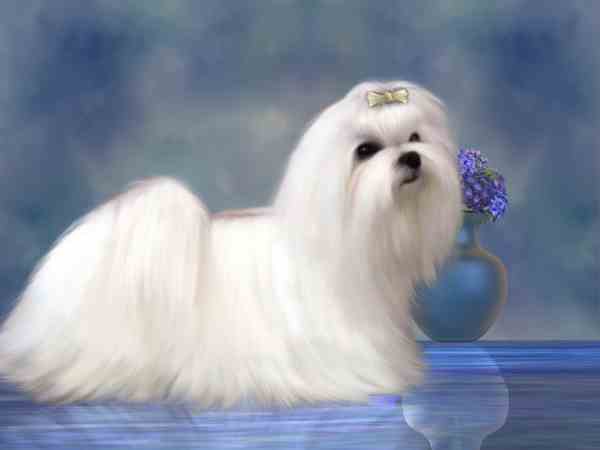 The Maltese Dog in a full show coat.
The Maltese Dog in a full show coat.What is known is that they came from the Mediterranean island of Malta, although the name Maltese is a 20th century creation. Maltese dogs make great small pets because they are naturally cuddly and thrive on your love and attention.
They do well with children as long as children are taught how to handle these small dogs.
They are very playful, and their energy level stays high throughout their life span. They are truly a people dog, preferring to be near them at all times.
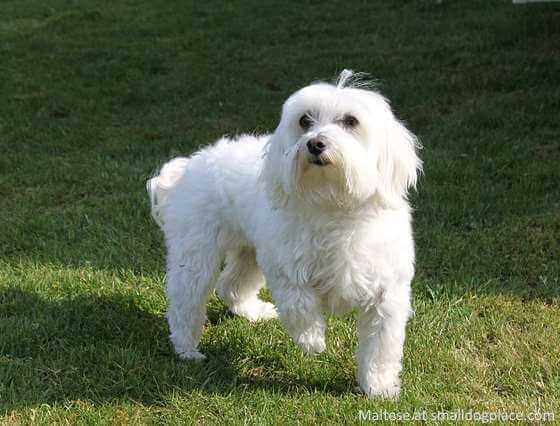
Maltese Dog Breed At a Glance
| Traits | Rating |
|---|---|
| Playfulness | |
| Affection Level | |
| Friendliness Towards Strangers | |
| Good with Children | |
| Good with Other Dogs | |
| Good for First Time Owners | |
| Exercise Needed | |
| Ease of Training | |
| Watch Dog Ability | |
| Grooming Requirements | |
| Shedding | |
| Cold Tolerant | |
| Heat Tolerant |
Dog Breed Ratings Got You a Little Confused?
Here's a little help in understanding them
- Playfulness: Most Playful = 5 Least Playful = 1
- Affection: Most Affectionate = 5 Least Affectionate = 1
- Friendliness Towards Strangers: Most Friendly = 5 Least = 1
- Good With Children: Great= 5 Not Good with Children = 1
- Good With Dogs: Great = 5 Not Good Around Dogs = 1
- Good With First Time Owners: Fine=5 Not Appropriate = 1
- Exercise Required: Extensive Daily Exercise = 1 Minimal = 1
- Ease of Training: Very Easy = 5 Difficult = 1
- Watch Dog: Excellent Watch Dog = 5 Minimal = 1
- Grooming: Time Consuming = 5 Minimal = 1
- Shedding: Heavy Shedder = 5 Minimal = 1
- Cold Tolerance: Well Tolerated = 5 Poor Tolerance = 1
- Heat Tolerance: Well Tolerated = 5 Poor Tolerance = 1
Quick Facts About Maltese Dogs
Other Names Used: Melitae Dog, Ye Ancient Dogge of Malta, Comforter, Spaniel Gentle, Shock Dog, Maltese Lion Dog
Affiliation: AKC: Toy, UK: Companion, CKC: Group 5-Toys
Height: 7 to 9 inches (20–23 cm)
Weight: 4-7 pounds (3–4 kg)
Coat Type: Long, silky, single coat
Colors: White with small amount of cream or lemon around ears permissible
Country of Origin: Malta
Activity Level: Moderate
Life Expectancy: 12-15 years
Good with Children: Yes, if children are taught to respect their small size
Good with other pets: Yes
History of Maltese Dogs
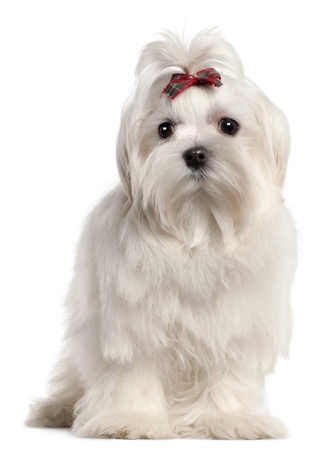
This ancient breed originated in the Mediterranean island of Malta, an ancient trading port. They remained isolated on the island for a long time.
It has been identified as being a favorite among ladies in Imperial Rome and was dubbed the “Roman Ladies Dog.”
In Greece, the first know written record of the breed was made by Aristotle in 350 BC. He attributed the origins of the breed to Malta, but there is some controversy about its true origins.
Some believe that Maltese dogs were one of the original French breeds and they do appear to be a close relative of the Bichon, Bolognese, Cotton de Tulear and Havanese.
Another
reason for the confusion is that the dog traveled extensively throughout the
old world being used in trade as barter for things such as Chinese silk. When they
arrived in Europe, they became popular with the upper class, allegedly
including Mary, Queen of Scotts, Josephine Bonaparte, and Marie Antoinette.
The Maltese was first introduced in America in the 1870’s and recognized by the American Kennel Club in 1888.
Maltese Dogs Personality
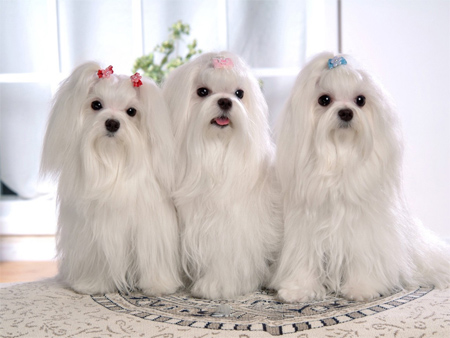
Although the Maltese has been bred for years to be a companion dog, he is very capable of catching rats like a terrier might, and they retain that alert, lively, intelligent personality trait.
Even though they might be capable of ratting, most owners don’t think of their sweet, refined dog as such. The Maltese is equally happy remaining by your side or enjoying a brisk walk. They are an active breed but do not require much in the way of exercise.
Most of their needs can be met as they follow you from room to room in the home. They do enjoy a romp in the yard, but most prefer to explore than run around.
The AKC standard describes the Maltese as being “gentle mannered and affectionate.” They make great watch dogs because they never seem to miss a new sound.
While being very affectionate with his owners, he is also an individualist and may not take to strangers at first.
He is quite fearless, often to the point of wanting to protect his owners, but don’t expect him to be a true guard dog. No small dogs can take on that role.
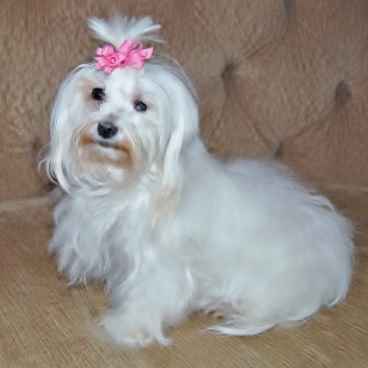 This is my own dog, Jasmine
This is my own dog, JasmineHealth Concerns of Maltese Dogs
The Maltese is a generally healthy dog but there are some
diseases are known to exist in the breed. Many diseases are common to all breeds. The ones below can be found in the Maltese and other small breed dogs.
Luxated Patellas
This common problem seen in small breed dogs involves the petalla or kneecap. It occurs when the knee cap (Patella) the femur and the tibia (leg bones) do not line up properly allowing the knee to slip in and out of place.
Lameness or an abnormal gait that looks a lot like a skip or hop occurs. It is present at birth, but the actual symptoms do not show up until later.
When they slippage occurs over time, it leads to inflammation, arthritis, and pain. Doctors grade patellar luxation from I to IV where grade I is the occasional slippage causing temporary lameness to grade IV where the vet cannot manually realign the knee.
Cardiac Problems
Maltese rank 117th by the OFA on breeds most affected by cardiac problems. Even with this low rank, heart problems are the number one cause of death in the breed.
Over twenty percent of Maltese deaths are from cardiac problems with mitral valve disease being the primary one.
Mitral Valve Disease
In mitral valve disease there is a backward flow of blood, or blood going in the wrong direction. The type of blood flow prevents the oxygenated blood from flowing to the cells in the body. It is the most common cause of a heart murmur.
The condition usually strikes middle age and older dogs. In the beginning, there are no obvious symptoms. As time progresses, mitral valve disease leads to congestive heart failure as the valve leaks more and more blood. As time progresses, the dog becomes less able to exercise, may develop a cough and fluid begins to pool in the lungs.
Patent Ductus Arteriosus - PDA
This is a serious and sometimes fatal defect of the heart. In the fetus, a shunt or ductus arteriosus in the heart allows blood to bypass the lungs that will not begin to work until the puppy is born.
Once the puppy is born this duct or shunt should close so normal circulation can occur. When this does not occur, blood flow becomes a problem resulting in a heart murmur, cardiac arrhythmia and poorly oxygenated blood. Long term prognosis is poor.
Juvenile Cellulitis aka "Puppy Strangles"
This is a condition of unknown origin occurring several different breeds. It only affects puppies between the ages of three weeks to about four months. Puppy Strangles affects the face, the outer ears and the salivary lympth nodes.
Symptoms occur quickly and include a swollen face, oozing skin, ear infection and lethargy. The lesions become crusted and the skin is tender to touch. Puppies loose their appetite and may have a fever.
If not treated, scaring can occur. Treatment consists of topical ointments, corticosteroids, and even chemotherapy. If a secondary bacterial infection is present, antibiotics will be prescribed. It usually does not reoccur.
Progressive Retinal Atrophy (PRA)
Progressive Retinal Atrophy is an inherited disease seen in almost all types of dogs. The retina is that part of the eye where rods and cones are located and the disease occurs as the rods die. The first symptoms to appear are night blindness followed by total vision loss within a year if the dog does not receive treatment.
For more information on the Maltese Dog, visit the national breed club or the American Kennel Club

Care of Maltese Dogs
The Maltese dog is relatively easy to care for, especially if you enjoy grooming. There are a few things to keep in mind.
Training
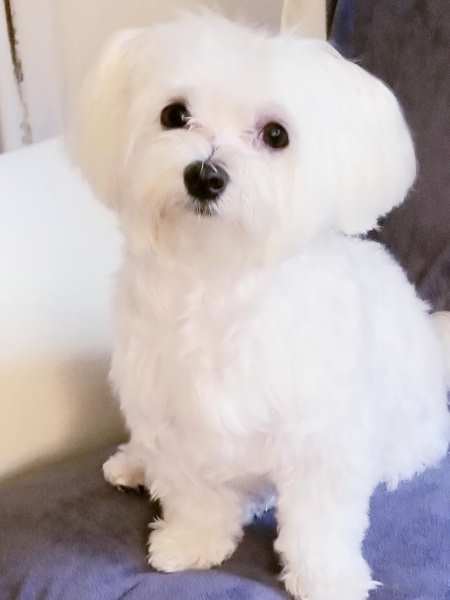
Though the Maltese dog looks to be delicate and frail, they are anything but and can be lively and as athletic as you need them to be. They do well in competitive sports and learn quickly.
Housebreaking may be a little harder but consistency is important and a positive approach will go a long way towards making the process faster and more efficient.
They learn easily because they are intelligent but their stubborn streak may emerge from time to time making training them a bit more frustrating. Patience, lots of praise and reinforcements using treats works very well.
Energy and Exercise
Maltese dogs are surprisingly very active and have lots of energy. They don't require a great deal of exercise, though because they tend to be velcro dogs meaning they will follow you everywhere. As long as you move around they will too, getting most of their energy needs met.
A daily walk and dose of fresh air is always appreciated or a romp in a fenced in area will also fulfill their exercise requirements. Some, but not all will enjoy a game of fetch with their favorite human.
Problem Behaviors
Most of the Maltese's problem behaviors revolve around their need to be next to their person. Some get severe cases of separation anxiety that can be accompanied with destructive tendencies and barking. Early socialization helps to prevent some of these tendencies.
Maltese owners also report that barking can be a problem as well as nipping at the ankles. Both of these behaviors can be controlled if taught right from the start.
Diet and Nutrition
Adult Maltese dogs should be feed a high quality homemade, raw or commercially available dog food twice a day. Their daily rations should be divided into two to assure they are getting what they need and not much more. Some of these dogs tend towards being overweight especially after they have been fixed.
You will want to factor in treats and training rewards and not overdo it with extra unnecessary calories.
Training treats can be broken down into tiny pieces and supplements can be given as treats. Some fruits and vegetables make good training rewards or stand alone treats. If using supplements, consider ones that can be offered as treats.
Best Owners for Maltese Dogs
 This is Lucia from New York, USA
This is Lucia from New York, USAThe Maltese Dog Breed can be a good choice for virtually anyone wanting a small long haired dog.
Singles, Couples, and Families make good dog owners as well as those that live in apartments or in rural settings. This breed is also an excellent choice for a first time dog owner.
Coat and Grooming
The Maltese Dog’s white coat is his crowning glory, but with it comes some work to keep the locks flowing and tangle free. Since they do not shed, they are considered to be a good breed for those with allergies.
The standard allows for some cream or lemon coloring around the ears. If kept long, brushing is needed at least every other day and preferable daily.
The coat is considered to be a single one with no undercoat, but because the Maltese does not shed, hairs that are lost work their way into knots, tangles, and mats if not brushed out.
Hair on the top of the head is tied up in a top knot which keeps the hair out of the dog’s eyes. A typical show topknot consists of two separate strands each holding a bow.
Besides regular brushing, a bath is also important for a white dog, especially if he goes outdoors frequently and especially necessary for those who love to roll in the grass.
For best results after a bath, a high quality whitening shampoo is a must. Any areas of the coat that have discolored can sometimes be brought back by leaving the shampoo on for 10-15 minutes before rinsing.
A good brush before the bath is essential to
assure that all mats have been removed. Both pin and slicker type brushes work well with the Maltese coat.
Most owners keep those flowing locks trimmed in a puppy cut of one to two inches for easier management.
Show coats are stunning but for anyone who thinks they might like to keep their pet in this spectacular style, beware. There is much more that goes into a Maltese Show Coat than simply brushing and letting mother nature do her thing.
Tear stains are also a major issue with
some Maltese dogs and trying to remove them becomes a major headache for their
owners. Just because the Maltese is a white dog does it mean that they are doomed to have tear stains. This is a fixable problem.
Famous Maltese Owners
Italian poet, Ludovico Ariosto memorialized the dog in his poem “Orlando Furioso”.
In Britain, royals such as Mary Queen of Scots (1542-1587 ), Queen Elizabeth I (1533-1603), and Queen Victoria (1819-1901) were all Maltese owners.
Other famous Maltese owners have included Elvis, Elizabeth Taylor, Marilyn Monroe, Snoop Dogg and Susan Sarandon.
“Some of my best leading men have been dogs and horses,” Elizabeth Taylor
She once owned a Maltese named, Sugar.
More Resources to Explore
If you are considering the possibility of adding a Maltese puppy or dog to your family, you will want to check out some of the resources below.
About Janice (author and voice behind this site)
Having lived with dogs and cats most of her life, Janice served as a veterinary technician for ten years in Maryland and twelve years as a Shih Tzu dog breeder in Ohio.
Her education includes undergraduate degrees in Psychology with a minor in biology, Early Childhood Education, and Nursing, and a master's in Mental Health Counseling.
She is a lifelong learner, a dog lover, and passionate about the welfare of animals. Her favorite breed for over 50 years has been the Shih Tzu, but she has also lived with poodles, Maltese, Yorkshire Terriers, beagles, English bulldogs, carin terriers, and a Cocker Spaniel.
When not writing, reading, and researching dog-related topics, she likes to spend time with her eight Shih Tzu dogs, husband, and family, as well as knitting and crocheting. She is also the voice behind Miracle Shih Tzu and Smart-Knit-Crocheting
Does This Article Deserve Your Thumbs Up?
We always appreciate your support and encouragement. Your thumbs up means so much to us. Please like this article.
If you find this page or any page on Small Dog Place Helpful, or useful in anyway, I'd love it if you would click the small heart found on the bottom right of each page.
You can also share or bookmark this page -- just click on the:

Free Monthly Newsletter
Sign Up for Our Free Newsletter and get our Free Gift to You.
my E-book, The Top 10 Mistakes People Make When Choosing a Dog (and how to avoid them)
